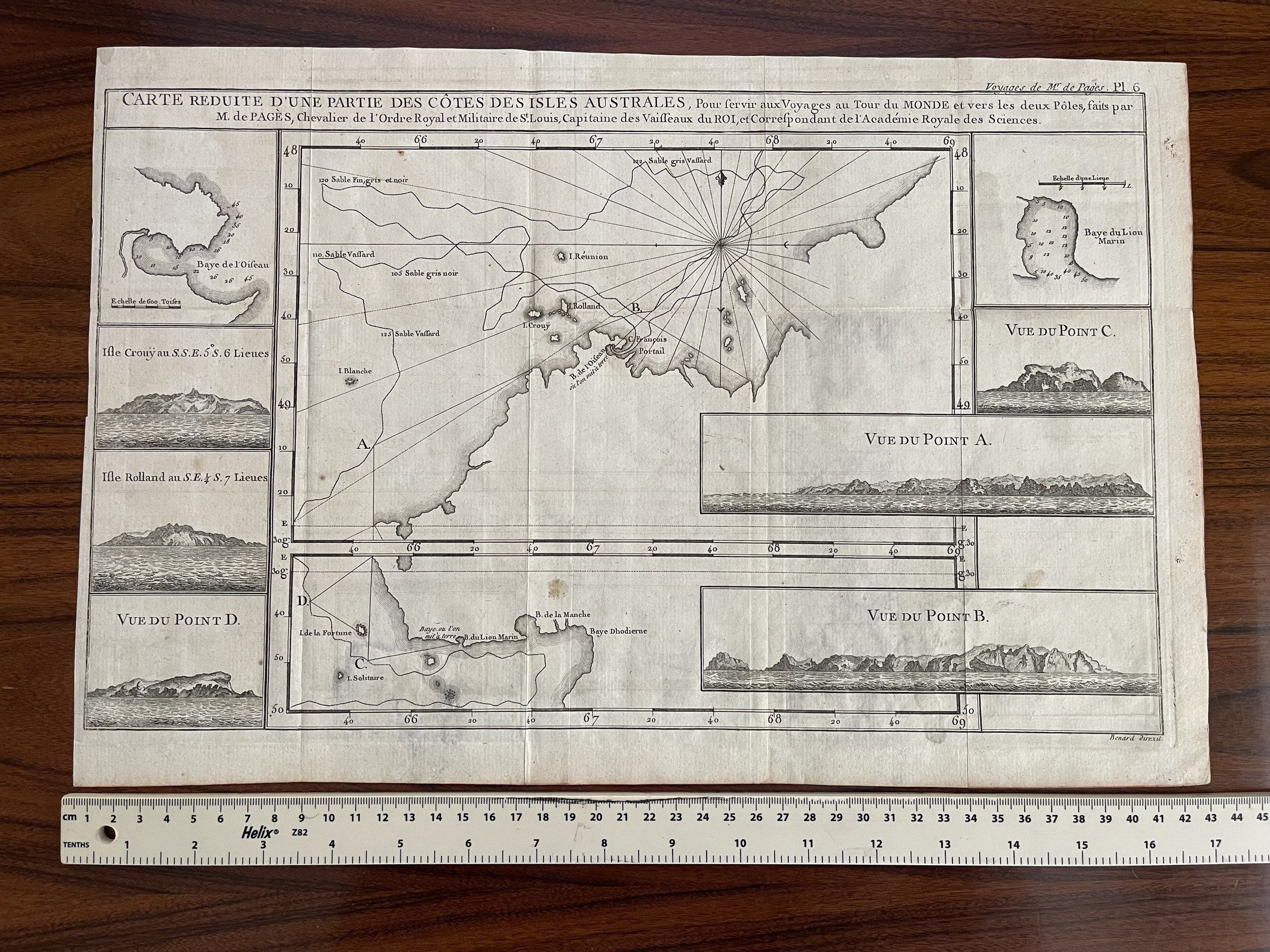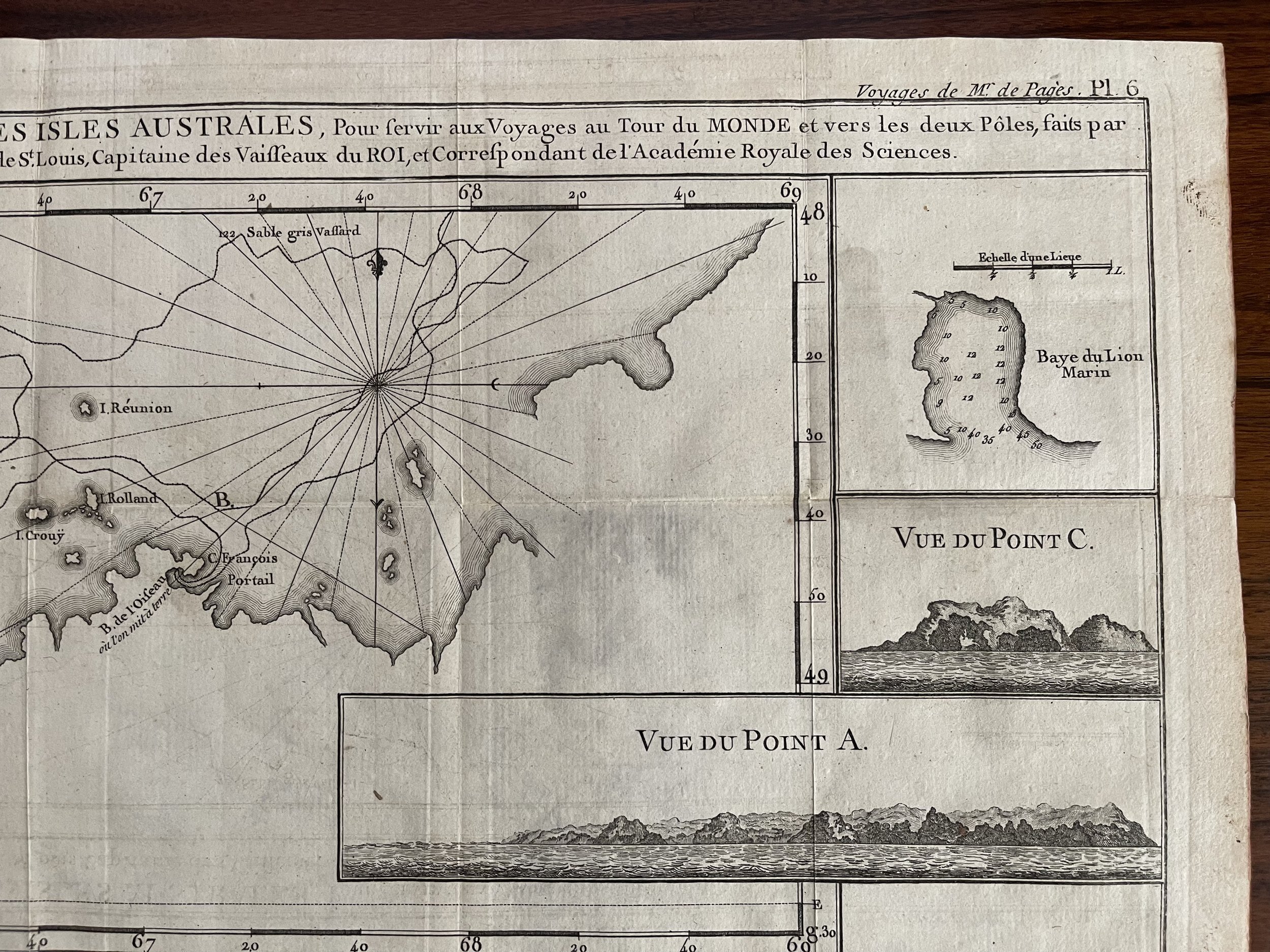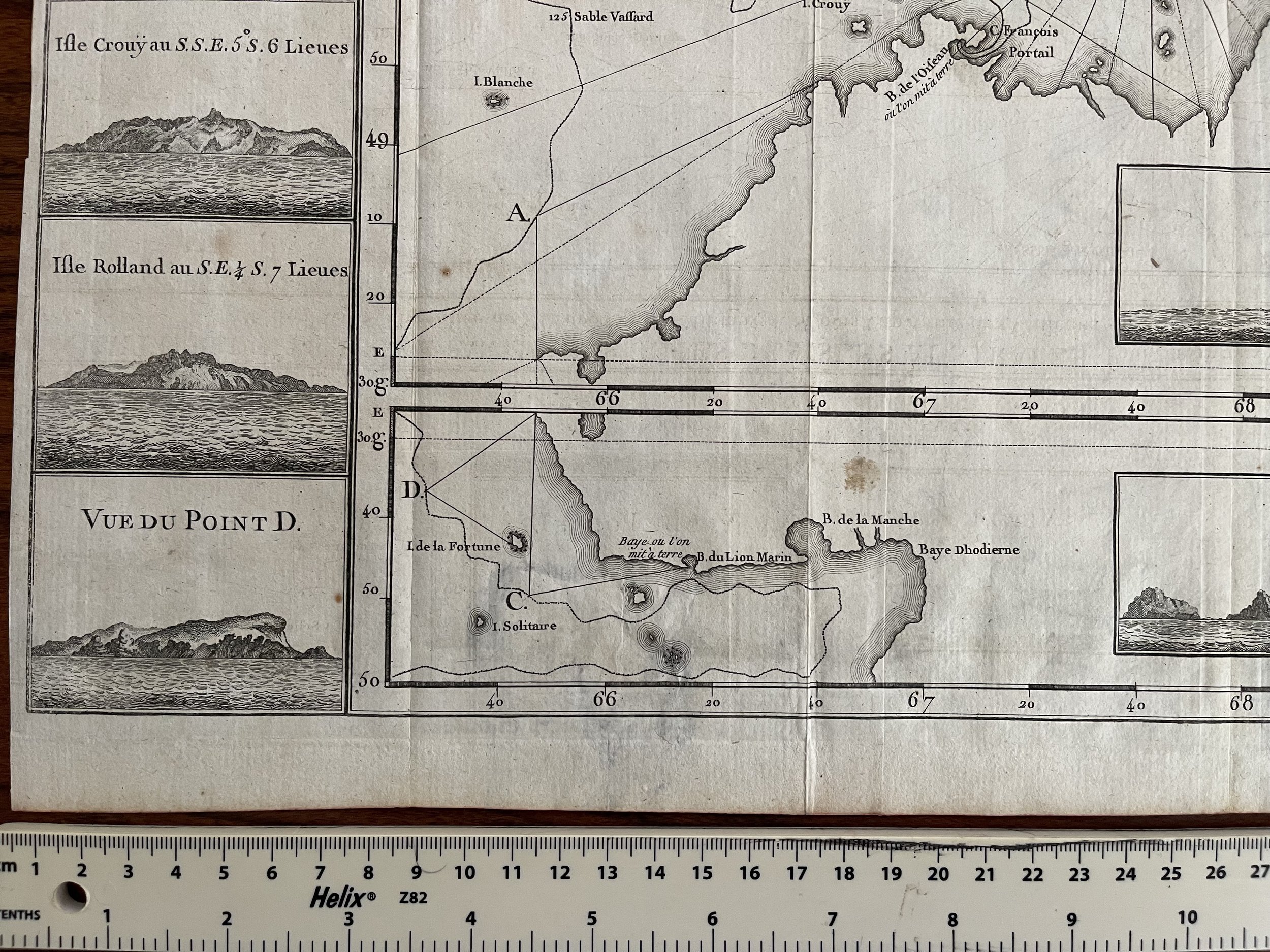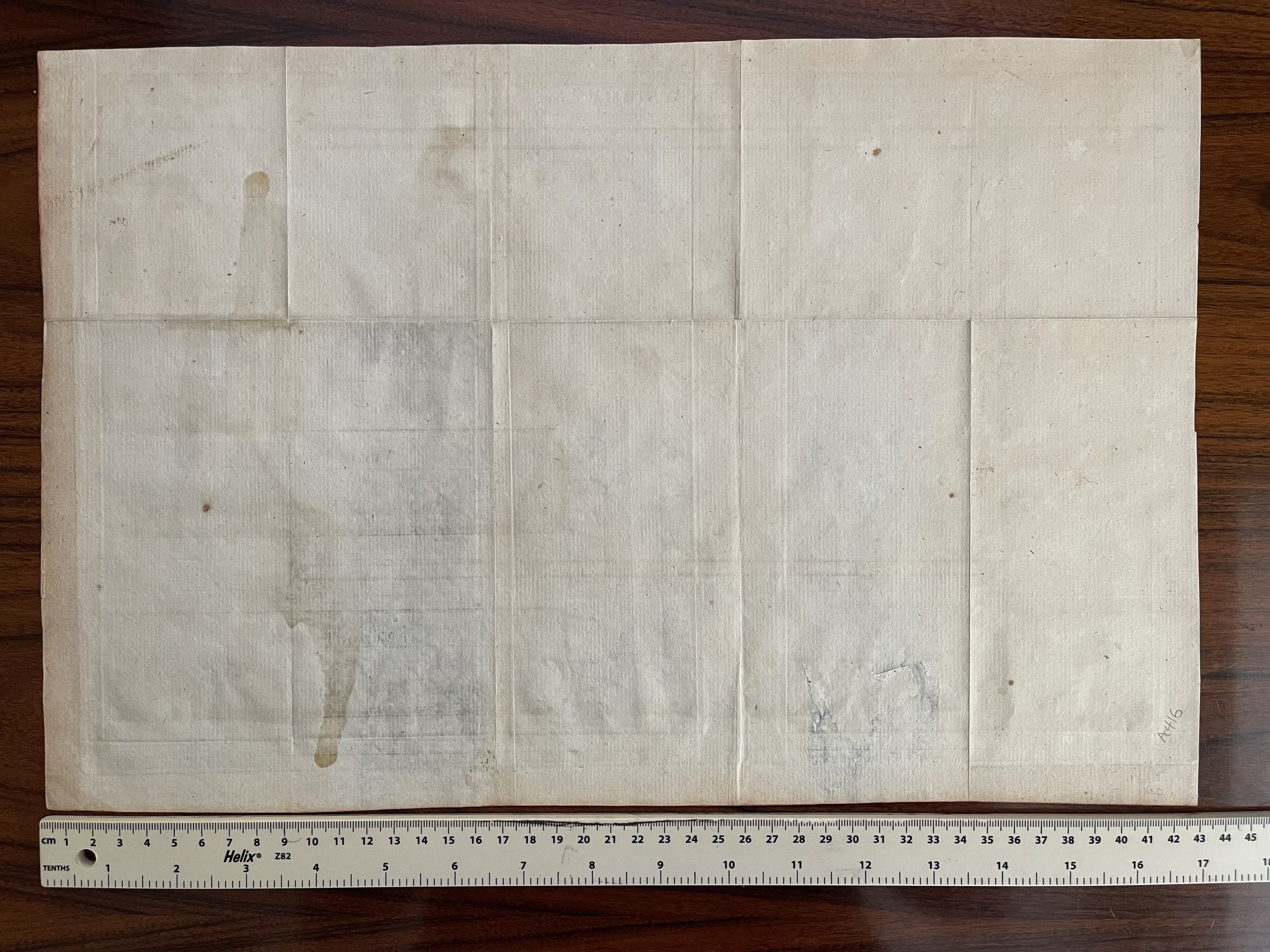Carte Reduite D'Une Partie Des Côtes Des Isles Australes, pour servir aux voyages au tour du Monde et vers les deux Poles - Jacques Renaud Benard - 1782
Exceptionally rare example and one of the first engravings of the Antarctic Peninsula. Engraved by Jacques Renaud Benard (Direxit - Possibly by one of his apprentices or associated engravers).
Born of noble family, a French naval officer, Pierre Marie François de Pages, made a five-year voyage around the world, between 1767 and 1771. Subsequently he took part in a two year voyage to the South Pole, between 1773 and 1774. Finally he made a trip to the North Pole in 1776. These voyages were recounted in his publication of 1782. In May 1773, Pages set sail with Yves de Kerguelen-Tremarec on the latter’s second voyage to ‘France Australe’ and sighted Kerguelen Island. In 1772 Kerguelen had discovered the island which was christened Terre de Desolation but was subsequently renamed by Captain James Cook as Kerguelen Island. ‘… Some of Monsieur de Kerguelen's own countrymen seem more desirous than we are to rob him of his honour. It is very remarkable, that Monsieur de Pages never once mentions the name of his commander; and, though he takes occasion to enumerate the several French explorers of the southern hemisphere, from Gonneville down to Crozet, he affects to preserve an entire silence about Kerguelen, whose first voyage, in which the discovery of this considerable tract of land was made, is kept as much out of sight as if it never had taken place. Nay, not satisfied with refusing to acknowledge the right of another, he almost assumes it to himself. For, upon a map of the world annexed to his book, at the spot where the new land is delineated, we read this inscription, Isles nouvelles Australes vuees par Monsieur de Pages, en 1774. He could scarcely have expressed himself in stronger terms, if he had meant to convey an idea that he was the conductor of the discovery. And yet we know that he was only a lieutenant on board of one of three ships commanded by Kerguelen; and that the discovery had been already made in a former voyage, undertaken while he was actually engaged in his singular journey round the world…’.
Jacques Renaud Benard (AKA) Robert Bénard (1734 in Paris – 1777) was a French engraver.
Specialised in the technique of engraving, Robert Bénard is mainly famous for having supplied a significant amount of plates (at least 1,800) to the Encyclopédie by Diderot & d'Alembert from 1751.
Later, publisher Charles-Joseph Panckoucke reused many of his productions to illustrate the works of his catalog.
Biographical research established in 2019 that his real name was Jacques Renaud Benard, that he was born in 1731 at Rosny-sous-Bois, and that he died in Paris in 1794. [1]
The signature "Benard fecit" on plates probably indicates the work of his own hand; the signatures "Benard Direx" and "Benard Direxit" indicate the work of the atelier of engravers he directed for many years.
Some foxing and darkening in some areas, otherwise in good condition for its age.
Exceptionally rare example and one of the first engravings of the Antarctic Peninsula. Engraved by Jacques Renaud Benard (Direxit - Possibly by one of his apprentices or associated engravers).
Born of noble family, a French naval officer, Pierre Marie François de Pages, made a five-year voyage around the world, between 1767 and 1771. Subsequently he took part in a two year voyage to the South Pole, between 1773 and 1774. Finally he made a trip to the North Pole in 1776. These voyages were recounted in his publication of 1782. In May 1773, Pages set sail with Yves de Kerguelen-Tremarec on the latter’s second voyage to ‘France Australe’ and sighted Kerguelen Island. In 1772 Kerguelen had discovered the island which was christened Terre de Desolation but was subsequently renamed by Captain James Cook as Kerguelen Island. ‘… Some of Monsieur de Kerguelen's own countrymen seem more desirous than we are to rob him of his honour. It is very remarkable, that Monsieur de Pages never once mentions the name of his commander; and, though he takes occasion to enumerate the several French explorers of the southern hemisphere, from Gonneville down to Crozet, he affects to preserve an entire silence about Kerguelen, whose first voyage, in which the discovery of this considerable tract of land was made, is kept as much out of sight as if it never had taken place. Nay, not satisfied with refusing to acknowledge the right of another, he almost assumes it to himself. For, upon a map of the world annexed to his book, at the spot where the new land is delineated, we read this inscription, Isles nouvelles Australes vuees par Monsieur de Pages, en 1774. He could scarcely have expressed himself in stronger terms, if he had meant to convey an idea that he was the conductor of the discovery. And yet we know that he was only a lieutenant on board of one of three ships commanded by Kerguelen; and that the discovery had been already made in a former voyage, undertaken while he was actually engaged in his singular journey round the world…’.
Jacques Renaud Benard (AKA) Robert Bénard (1734 in Paris – 1777) was a French engraver.
Specialised in the technique of engraving, Robert Bénard is mainly famous for having supplied a significant amount of plates (at least 1,800) to the Encyclopédie by Diderot & d'Alembert from 1751.
Later, publisher Charles-Joseph Panckoucke reused many of his productions to illustrate the works of his catalog.
Biographical research established in 2019 that his real name was Jacques Renaud Benard, that he was born in 1731 at Rosny-sous-Bois, and that he died in Paris in 1794. [1]
The signature "Benard fecit" on plates probably indicates the work of his own hand; the signatures "Benard Direx" and "Benard Direxit" indicate the work of the atelier of engravers he directed for many years.
Some foxing and darkening in some areas, otherwise in good condition for its age.
Exceptionally rare example and one of the first engravings of the Antarctic Peninsula. Engraved by Jacques Renaud Benard (Direxit - Possibly by one of his apprentices or associated engravers).
Born of noble family, a French naval officer, Pierre Marie François de Pages, made a five-year voyage around the world, between 1767 and 1771. Subsequently he took part in a two year voyage to the South Pole, between 1773 and 1774. Finally he made a trip to the North Pole in 1776. These voyages were recounted in his publication of 1782. In May 1773, Pages set sail with Yves de Kerguelen-Tremarec on the latter’s second voyage to ‘France Australe’ and sighted Kerguelen Island. In 1772 Kerguelen had discovered the island which was christened Terre de Desolation but was subsequently renamed by Captain James Cook as Kerguelen Island. ‘… Some of Monsieur de Kerguelen's own countrymen seem more desirous than we are to rob him of his honour. It is very remarkable, that Monsieur de Pages never once mentions the name of his commander; and, though he takes occasion to enumerate the several French explorers of the southern hemisphere, from Gonneville down to Crozet, he affects to preserve an entire silence about Kerguelen, whose first voyage, in which the discovery of this considerable tract of land was made, is kept as much out of sight as if it never had taken place. Nay, not satisfied with refusing to acknowledge the right of another, he almost assumes it to himself. For, upon a map of the world annexed to his book, at the spot where the new land is delineated, we read this inscription, Isles nouvelles Australes vuees par Monsieur de Pages, en 1774. He could scarcely have expressed himself in stronger terms, if he had meant to convey an idea that he was the conductor of the discovery. And yet we know that he was only a lieutenant on board of one of three ships commanded by Kerguelen; and that the discovery had been already made in a former voyage, undertaken while he was actually engaged in his singular journey round the world…’.
Jacques Renaud Benard (AKA) Robert Bénard (1734 in Paris – 1777) was a French engraver.
Specialised in the technique of engraving, Robert Bénard is mainly famous for having supplied a significant amount of plates (at least 1,800) to the Encyclopédie by Diderot & d'Alembert from 1751.
Later, publisher Charles-Joseph Panckoucke reused many of his productions to illustrate the works of his catalog.
Biographical research established in 2019 that his real name was Jacques Renaud Benard, that he was born in 1731 at Rosny-sous-Bois, and that he died in Paris in 1794. [1]
The signature "Benard fecit" on plates probably indicates the work of his own hand; the signatures "Benard Direx" and "Benard Direxit" indicate the work of the atelier of engravers he directed for many years.
Some foxing and darkening in some areas, otherwise in good condition for its age.
Code : A416
Cartographer : Cartographer / engraver: Jacques Renaud Benard
- Pierre Marie Francouis de Pages, Captain Cook.
Date : 1782
Size : Sheet size: 43 X 31cm
Availability : Available
Type - Genuine Antique
Grading - B+





